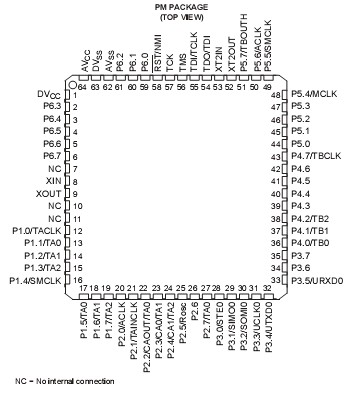Features: `Low Supply-Voltage Range, 1.8 V to 3.6 V
`Ultralow-Power Consumption:
- Active Mode: 160 A at 1 MHz, 2.2 V
- Standby Mode: 0.9 A
- Off Mode (RAM Retention) : 0.1 A
`Five Power-Saving Modes
`Wake-Up From Standby Mode in less than 6 s
`16-Bit RISC Architecture, 125-ns Instruction Cycle Time
`16-Bit Timer_B With Three Capture/Compare-With-Shadow Registers
`16-Bit Timer_A With Three Capture/Compare Registers
`On-Chip Comparator
`Serial Communication Interface (USART), Software Selects Asynchronous UART or Synchronous SPI
`Programmable Code Protection With Security Fuse
`Family Members Include:
- MSP430C1331: 8KB ROM, 256B RAM
- MSP430C1351: 16KB ROM, 512B RAM
`Available in 64-Pin Quad Flat Pack (QFP)
`Emulation: Use MSP430F13xIPM
`For Complete Module Descriptions, See the MSP430x1xx Family User's Guide, Literature Number SLAU049
Pinout Specifications
Specificationsabsolute maximum ratings over operating free-air temperature (unless otherwise noted)
Voltage applied at VCC to VSS . . . . . . . . . . . . . . . . . . . . . . . . . . . . . . . . . . . . . . . . . . . . . . . . . . . -0.3 V to + 4.1 V
Voltage applied to any pin (see Note) . . . . . . . . . . . . . . . . . . . . . . . . . . . . . . . . . . . . . . . . . . . -0.3 V to VCC +0.3 V
Diode current at any device terminal . . . . . . . . . . . . . . . . . . . . . . . . . . . . . . . . . . . . . . . . . . . . . . . . . . . . . . ±2 mA
Storage temperature (unprogrammed device) . . . . . . . . . . . . . . . . . . . . . . . . . . . . . . . . . . . . . . . . . -55 to 150
Storage temperature (programmed device) . . . . . . . . . . . . . . . . . . . . . . . . . . . . . . . . . . . . . . . . . . . . -40 to 85
Stresses beyond those listed under "absolute maximum ratings" may cause permanent damage to the device. These are stress ratings only, and
functional operation of the device at these or any other conditions beyond those indicated under "recommended operating conditions" is not implied. Exposure to absolute-maximum-rated conditions for extended periods may affect device reliability.
NOTE: All voltages referenced to VSS . The JTAG fuse-blow voltage, VFB, is allowed to exceed the absolute maximum rating. The voltage is applied
to the TDI/TCLK pin when blowing the JTAG fuse.
DescriptionThe Texas Instruments MSP430C1331 ultralow-power microcontrollers consist of several devices featuring different sets of peripherals targeted for various applications. The architecture, combined with five low power modes is optimized to achieve extended battery life in portable measurement applications. The MSP430C1331 features a powerful 16-bit RISC CPU, 16-bit registers, and constant generators that attribute to maximum code efficiency.
The digitally controlled oscillator (DCO) of MSP430C1331 allows wake-up from low-power modes to active mode in less than 6 s.
The MSP430C1331 is a microcontroller configuration with two built-in 16-bit timers, one universal serial synchronous/asynchronous communication interfaces (USART), and 48 I/O pins.
Typical applications of MSP430C1331 include sensor systems that capture analog signals, convert them to digital values, and process and transmit the data to a host system. The timers make the configurations ideal for industrial control applications, hand-held meters, etc.

 MSP430C1331 Data Sheet
MSP430C1331 Data Sheet







